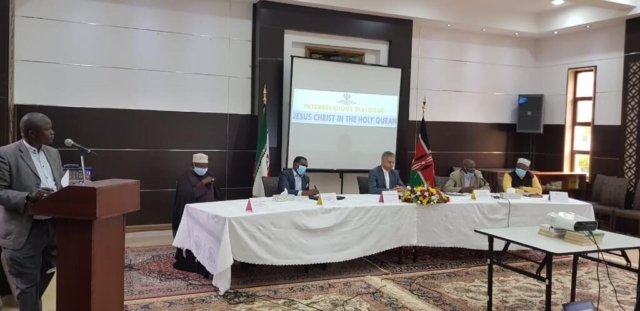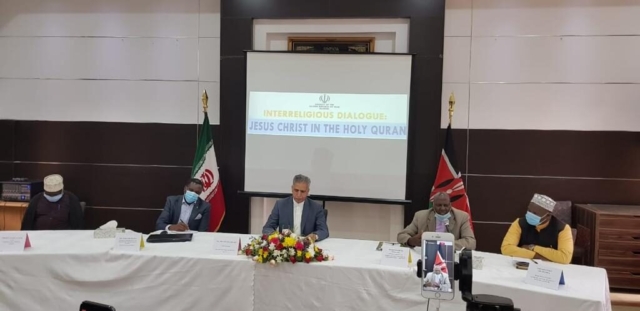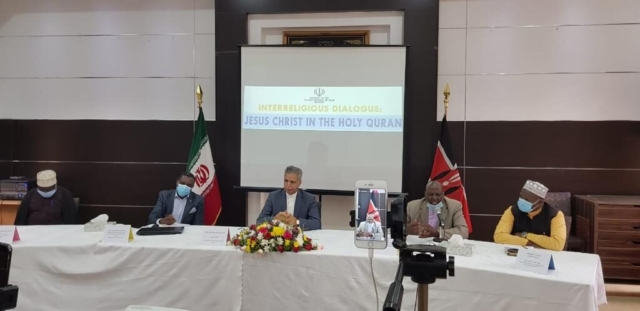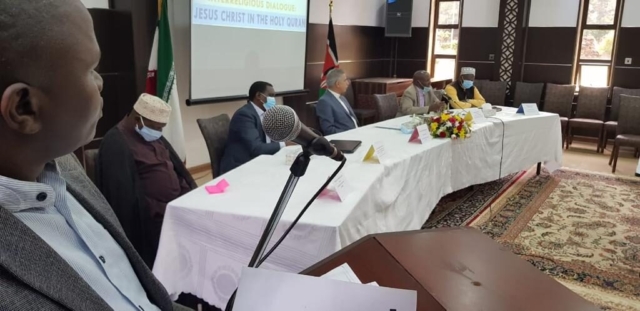Jesus in Islam webinar was aimed at enhancing interreligious relations between Muslims and Christians. The event was conducted on the eve of Christmas when Christians celebrate the birth of Jesus Christ according to Christianity. Therefore the Cultural council of the Embassy of IRI joined hands with Christian brothers and sisters and in show of solidarity to demonstrate solidarity, unity and brotherhood as equals in humanity.
The webinar conference took place on 24 December 2020 from 10.00 am to 12.30 pm and streamed live both on Facebook and Instagram.
The panelists included the following:
- E Dr. Jafar Barmaki Ambassador of IRI to Kenya
- Bishop David Thagana General Secretary Federation of Evangelical & Indigenous Christian Churches of Kenya (FEICCK)
- Mahdi Kassim Imam Park Road Shia Mosque
- Al Yusuf Abuhamza Director Religious Affairs, Supreme council of Kenya Muslims (SUPKEM).
- Kahumbi Maina Senior Lecturer, Department of Philosophy and Religious Studies, Kenyatta University.
The webinar was moderated by Athman Farsi a staff of the Cultural council of the Embassy of IRI, Nairobi.
The webinar started by H.E Dr. Jafar Barmaki who delivered a speech on “Peaceful coexistence of religions in Iran”.
Excellency began by wishing Christians a Merry Christmas and a happy new year. He prayed to God to grant them joy of one million Angels as they happily celebrate with love of the God and Jesus Christ to be their closest companion during and after this Christmas.
Peace and security is brought about by peaceful existence. All divine religions and Prophets promote monotheism and savior of humanity and source of peace, security and loving the followers of other religions. Peaceful coexistence is treated as an achievement of Human war.
Islam as one of the divine religions encourages this practice of peaceful coexistence both in the Holy Quran and in the practical sunna (traditions) of the Holy infallibles.
Excellency demonstrated peaceful coexistence in the Holy Quran he quoted Quran 49:13, “O Mankind, we created you from single (pair) of a male and a female and made you into a nation and tribes that ye may know each other….” He said, this verse clearly indicates that there should be no discrimination based on clan, race, creed or religion. The word Islam refers to peace. Islamic teachings contain many ways of settling disputes amongst people and nations with the aim of establishing peace.
Islamic history shows how Muslims and non Muslims coexisted in peace in Madina. A charter declared by the Holy Prophet in 622 AD was the best example of established communal coexistence of different beliefs. This policy was also exercised by successive rulers of different Muslim territories of the Muslim world.
Unfortunately establishing peaceful coexistence is faced with challenges in the world. Several Muslim countries have been suffering from internal conflicts even among different Muslim groups. We have to strive to bring peace among religions. Iran is trying to have such environment.
Multiple religions and sects have shaped such environment in Iran in the course of the country’s history. Zoroastrianism was the main religion during the archaemenids and Sassanid Empire in 651 AD after the conquest of the Empire by Muslims, the people accepted Islam by their own choice as the main religion. According to the 2011 Iranian census, 99.98% of Iranians are Muslims while the rest of the population believe in other officially recognized religions; Christianity, Judaism and Zoroastrianism. These minority religions are recognized, protected, observed and have representation in Iranian Parliament. Iran is home to the second largest Jewish community in the Muslim world and the Middle East. Freedom of religion in Iran is marked by Iranian culture and politics. Iran is officially and in practice an Islamic Republic. The constitution of the Islamic Republic mandates that the official religion of Iran is Shia and also mandates other Islamic schools of thought are to fully accorded with respect to accord their followers freedom to practice their jurisprudence in performing religious rites. The constitution of Iran stipulates that Zoroastrians, Jews and Christians are recognized as religious minorities.
In the Islamic Republic of Iran, the freedom to perform religious ceremonies security of temples, holy places, the sanctity of spiritual figures, judicial independence, and economic activities in social relations are equally guaranteed for all citizens including all religious minorities.
The rights of religious minorities in Iran don’t change with the change of government because these rights are enshrined in the constitution. In order to preserve and sustain the identity of religious minority groups the constitution has provided grounds for public participation of minorities in the areas of presidential elections, Islamic consultative assembly and village councils. According to the constitution, the religious minorities in the Islamic republic have the right to have NGOs. Existence of schools for religious minorities is a clear indication of their academic justice. Followers of Christians, Jewish and Zoroastrians religions can hold religious rituals and ceremonies individually and collectively with numerous churches, synagogues and temples.
A friend questioned if there were Christian churches in Iran. In fact there are numerous churches and the oldest Christian church is in Iran. Saint Thaddeus Monastery in North West Iran is considered the oldest church in the world.
There are more than 30 synagogues in Tehran only. This shows coexistence of religions practiced in Iran. The 30 tire street in Tehran is a symbol of coexistence. The length of the street is less than a kilometer and is called a religious street. It accommodates holy places of Christianity, Judaism, Zoroastrianism and Islam.
Bishop David Thagana: Jesus in the Christian perspective
He said in Christian perspective, in the book of Genesis Chapter 3, the relationship of Man and God tarnished by the sin that Adam and Eve committed in the garden of Aden which was brought about by satan. Therefore there was need to restore relationship of man and God.
The foundation of Christianity is found in the Book of John 3:16 that says “For God so loved the world for gave his only son that whoever believes in him shall not perish but have eternal life”. He said therefore Jesus came as a gift to the world and was out of the love of God to man.
Bishop narrated how Jesus was born, later died on the cross to save by restoring the link between man and God by washing away the sins of man hence saving man from death and granting him eternal life.
Consequently, Jesus resurrected and ascended to heaven thereby creating a reconnection between man and God and through Jesus and believing in him, coexistence can be achieved.
He was thankful for the opportunity to engage in interreligious dialogue of this nature where he felt free to express himself.
Bishop requested Excellency to organize a visit of Bishops of Kenya to visit their counterparts in Iran and more so the ‘Religious street’ in Tehran.
Sh. Yusuf Abuhamza: SUPKEM’s contribution to the peaceful coexistence of Muslims and other religions in Kenya.
Sh. Abuhamza began his speech by outlining the objectives of SUPKEM. The objects of SUPKEM were all inclusive and works towards serving inter/intra religious dialogue in all areas of religion, politics, economy and social affairs as they continue to promote Islamic knowledge, culture and civilization. SUPKEM encourages working on things that unites people rather than issues that separate people.
Sh. Mahdi Kasim: Jesus Christ in the Holy Quran
An introduction Sh. Mahdi said that prophets were sent to a society and performed miracles depending on issues troubling them. Therefore, Jesus Christ was sent to the Jews at a time that they were suffering from diseases like blindness, leprosy, deaths and Jesus performed miracles to reinstate sight, cure leprosy and raising people from the dead in order to be easily accepted by people.
Sh. Mahdi gave an account of the lineage of Jesus Christ from Imran and how Holy Mariam was born, her growth until she conceived by way of a Miracle from Allah without of involvement of a man. He spoke of how Nabi Issa (a.s) spoke when still an infant giving testimony that he is a Son of Allah (s.w.t).
Sh. Mahdi said Jesus was given Injil that simply means “Good News”. Jesus was to bring peace, hope, to renew and reaffirm the laws that were there before to the community which had gone astray by building them spiritually and follow the laws of God. Quoting the Bible John 17:3 the everlasting Jesus said they know you only through one God and Jesus Christ whom you’ve sent.
Celebrating the Birth of Jesus Christ is in order despite difference calendar dates. The Quran encourages to call each other for a common goal and a Muslim is not complete until he believes in Jesus Christ.
Dr Kahumbi Maina: Points of convergence between Muslims and Christians
Dr. Kahumbi started by highlighting on the Muslims and Christian perspectives about Jesus Christ on birth, death, resurrection and second coming. Later dealt with commonalities on birth, pre-eminence of Prophethood of Jesus Christ, performance of miracles and extraordinary title given to Jesus (Messiah, Christ, etc). Finally, his opinion as an academician what he felt were points of convergence to include, the issues of commonality mentioned above, God foiled the plan of Jews killing Jesus, he defeated death and the second coming of Jesus.
He advised the organizers of such event to include as many clerics as possible.




